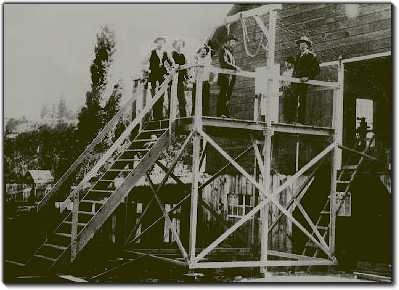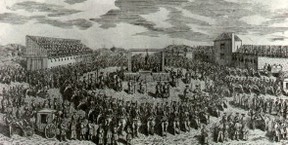 The numbers are truly staggering. In London, England, at Tyburn alone over 50,000 people were strung up from the gallows, during its 700 year history.
The numbers are truly staggering. In London, England, at Tyburn alone over 50,000 people were strung up from the gallows, during its 700 year history.
Across the Atlantic in America, an estimated 16,000 individuals were hanged nationwide between 1605 and 1967. Between 2007-2011, 1663 individuals were executed in Iran. The majority of them were hanged.
These are just snapshots of a worldwide figure for all time. Nobody could possibly estimate that. This method of execution has been going on for a very long time, which is why it figures so highly in our minds and in our language.
As a Briton, hanging was the favorite way of executing people in my country since the Anglo-Saxons invaded in the 4th century. No-one has been hanged here since 1964, with abolition in general terms occurring in 1967.
However a working gallows was maintained at Wandsworth Prison, in London. Every six months until 1998, it was checked to ensure that it was operational. Sacks the weight of the average British person were dropped through the trapdoor. The reason was not only that the Home Office thought that we should have one working, but also that High Treason and felony in Northern Ireland could potentially still carry the death penalty until then.
The legacy of so many centuries of capital punishment has left its stain in the British psyche and its landscape. There are no end of places called something like Gallows Hill or Hangman's Lane dotted around the country. They bear testimony to a terrible past.
I have only twice stepped foot in a death chamber and both of them were gallows within a prison. At Kilmainham Gaol, near Dublin, a quiet corridor ends in a shadowy room and a trapdoor. I flinched back instinctively, then forced myself to look.
It was such a small room, hidden away like a dirty secret. From that high beam had dangled the rope upon which so many Irish men and women had died. It raised goosebumps on my arms, though it was silent now.
The Galleries of Justice in Nottingham is housed in what was once the city's main prison. After meandering through centuries worth of ancient cells, following the history into the 20th century, I arrived in a relatively modern room. I looked around in interest, but there wasn't too much to see. Then I walked through an adjoining room and stopped dead.
There was the gallows, as it was done in England so recently. So close to the condemned cell. Should the death penalty ever return to Britain, it will be with a noose attached.
Former colonies of the British Empire received their gallows along with our historical governance. It is, for example, why Americans in Washington State may be hanged, or why Trinidad and Tobago is embroiled in debates about its own death penalty.
Of course, Britain isn't to blame for every use of hanging across the world, but its imperialist fervor to export it certainly played a large part in its on-going popularity.
But what do we really know about death by noose?




 The numbers are truly staggering. In London, England, at Tyburn alone over 50,000 people were strung up from the gallows, during its 700 year history.
The numbers are truly staggering. In London, England, at Tyburn alone over 50,000 people were strung up from the gallows, during its 700 year history.



 The idea is genius in its simplicity. All that is needed is something which with to suspend the individual and a handy beam to which it can be tied.
The idea is genius in its simplicity. All that is needed is something which with to suspend the individual and a handy beam to which it can be tied.


 Josiah Potts was well liked in the community of Elko, an outback town in the US state of Nevada. But his wife wasn't.
Josiah Potts was well liked in the community of Elko, an outback town in the US state of Nevada. But his wife wasn't. 
 Strict Gram
on 08/15/2014
Strict Gram
on 08/15/2014

 In 1989, a man named Charles R. Campbell was due to be hanged in Walla Walla State Penitentiary, in Washington State, USA.
In 1989, a man named Charles R. Campbell was due to be hanged in Walla Walla State Penitentiary, in Washington State, USA.




 Above and beyond all other methods of execution, hanging was meant to be a public spectacle. It has never managed to survive long, once taken indoors. To do that misses half of the point.
Above and beyond all other methods of execution, hanging was meant to be a public spectacle. It has never managed to survive long, once taken indoors. To do that misses half of the point.







 St Tydecho's Churches in West Waleson 09/03/2014
St Tydecho's Churches in West Waleson 09/03/2014
 Goodies for an Outlander Premiere Partyon 03/06/2015
Goodies for an Outlander Premiere Partyon 03/06/2015
 Holocaust Memorial Day Interview with Rainer Höss, Grandson of Rudolf Architect of Auschwitzon 01/24/2015
Holocaust Memorial Day Interview with Rainer Höss, Grandson of Rudolf Architect of Auschwitzon 01/24/2015
 Romantic Valentine Gifts for an Outlander Fanon 01/16/2015
Romantic Valentine Gifts for an Outlander Fanon 01/16/2015



Comments
I'm glad that you thought so. They were hard to write, but I did want the information to be out there.
Another very informative article
Another very informative article
I was one of those gruesome kids, who was interested in vampires, serial killers and other monsters. Back then, it was my life ambition to visit the Black Museum. I was gutted when I realised that it wasn't open to the public!
All grown up now, I probably wouldn't turn down the chance to see it, but it's not exactly on my list of ideal places to visit. I didn't know that there were death masks in there. That must have been creepy!
I'm glad that you found this article interesting.
Another very interesting article. I used to work in New Scotland Yard and once got to visit the Black Museum. In there they have a lot of the nooses used in the last hangings in the UK, with the names of those that were executed using them attached to each noose. Pretty macabre, particularly when the death masks of the executed were staring down at me from the walls!
It's part of a whole series of them. So far I've written about 4 of the 8 execution methods currently used in the world.
I see that you're back to the gruesome stuff, Jo.
If I'm honest, it's surprised me too, especially how people talk about hanging?
I'm surprised at the outcome of the vote. Gruesome article but necessary and well written , thanks
Awww re the eating and reading. <3
Yes, beheading is still very much used, notably in China and Afghanistan.
Hanging as a public spectacle pretty much depends where you are. American hangings take place within prison grounds. Only a handful of official witnesses are present. At the other end of the scale, Iranian hangings take place in public squares with thousands of people encouraged to turn up. It's not really down to the judge in any country, but the laws themselves.